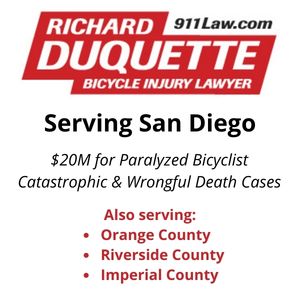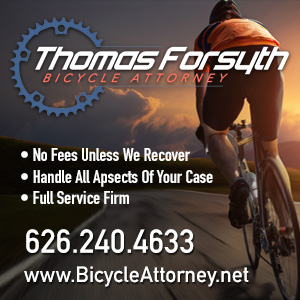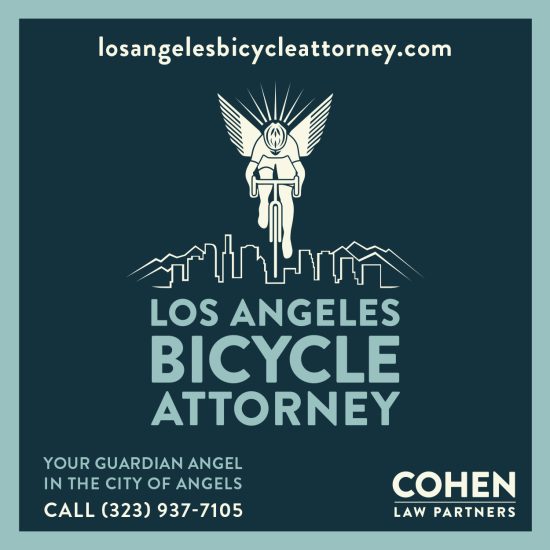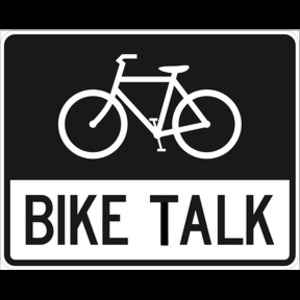
So much for that.
Just a year after LA County installed the first bike boulevard in East Los Angeles to semi-great fanfare, it’s already fading away to nothingness.
Presumably the roundabouts and curb extensions as part of the bike boulevard are still in place.
But without the markings on the street, shown here at Hubbard and Simmons, the Safe Route to School isn’t.
And the ballyhooed barrio bike boulevard is just so much blacktop.
Thanks to Aurelio Jose Barrera for the photos.

………
Nearly three-quarters of women in British cities never ride a bicycle, even though over two-thirds say their city would be a better place to live and work if more people did.
At least that’s better than Belfast, Northern Ireland, where the stats are even worse.
The Telegraph responds by saying it’s time for men and women to work together to get more women on bikes.
And The Guardian says the reason women don’t ride more is that roads designed by men are killing women.
………
Local
LADOT tells Bird to get their e-scooters the hell out of DTLA. After all, you wouldn’t want anything that would prove just how unnecessary cars really are in Downtown Los Angeles.
In an unrelated matter, Venice-based Bird is now worth $2 billion. Yes, with a B.
LAPD Foothill Community Police Station invites you to join them for CicLAvia The Valley on the 24th of this month, as it wends its way through Pacoima, Arleta and Panorama City.
Bike SGV is looking for interns and volunteers.
No bias here. KCBS-2 tweets that Santa Monica is considering a cap on those nuisance e-scooters.
Thirty members of my college fraternity will leave Long Beach this Thursday for a cross-country ride to raise funds for The Ability Experience; other teams will set out from San Francisco and Seattle.
State
Bike Snob visits the California L’Eroica, and takes to the road on a 102-year old bike with a single pizza-sized gear. Although he doesn’t say if that’s a large, xtra large, or individual sized pizza. Or whether it’s New York or Chicago style.
A three-time drunk driver gets off with five years behind bars for slamming his motorcycle into three bike riders while under the influence last year, after the victims called for leniency as he faced a possible 12 years in prison.
Palo Alto shifts its focus to calming residents outraged by traffic calming.
If California voters repeal the gas tax this fall, it will mean the loss of a number of Sacramento-area projects, including an improved street grid and protected bike lanes in the downtown area. Then again, that could all be moot if California ceases to exist.
National
A white conservative and a black liberal are following the path of the underground railroad as they ride from New Orleans to Canada, camera crew in tow.
A Reno columnist questions whether the arrival of LimeBike’s dockless bikeshare is just a PR stunt to make the city look good for Interbike.
Denver Streetsblog takes on the state’s victim-blaming traffic safety campaign, which barely feels a need to address dangerous drivers.
Now that’s planning. Kenosha WI has opened a new 1.5-mile off-road bikeway to prepare for additional bicycle traffic as new manufacturers come to town. And it’s pretty, too.
Michigan has become the latest state to adopt a three-foot passing distance, while allowing drivers to briefly cross the center line to pass a bike rider; student drivers will also be required to receive an hour of training in bike laws.
Bighearted Charlotte police arrange to get a new bicycle for a young autistic man after he crashed his old bike into a police cruiser when the brakes failed.
International
An advisory board has been formed with “all the major players” to develop standards for bike-to-vehicle contact, so autonomous cars don’t kill us all by accident. Except those major players seems to exclude every car maker other than Ford.
A new start-up wants to be the social media platform for the bike world.
Cycling Tips offers everything you always wanted to know about riding out of the saddle, but were afraid to ask.
Ninety-three bicyclists and pedestrians have died in Toronto in the two years since the mayor declared the city’s Vision Zero program.
You know you’ve got a problem when a rural Irish cycling club feels the need to make their club kit out of hi-viz just to stay alive.
Even in the Netherlands, authorities are trying to encourage more people to get out of their cars and onto bikes — and paying people 19 cents a mile to ride a bike instead of driving.
Former Laker Pau Gasol is one of us, as he’s briefly hospitalized following a fall from a rented bike while on vacation in Italy.
The president of Uganda bans hoodies in cars, and on motorcycles and bicycles to rid the country of the wrong element. Because clearly, bike-riding hoodie-wearers are natural born killers, and will leave the country if they have to bare their necks.
South African triathlete Mhlengi Gwala is walking without crutches, and preparing to get back on his bike just three months after a trio of men tried to cut his leg off with a chainsaw. And planning to ride 350 miles from Johannesburg to Durbin, South Africa, in just two days this December.
Just what every bike tourist needs. A $3,500 two-person inflatable tent from an Australian company, designed to be towed by a bicycle; there’s no word on how much it weighs, however.
Melbourne, Australia chases Chinese dockless bikeshare provider oBike out of town.
Caught on video: A Singapore website says a dangerous cyclist should be off the road after a near miss. Even though it looks like he may have had the right-of-way, and the left-turning driver failed to look for him as he came off the sidewalk into the crosswalk.
Competitive Cycling
Who says you have to see to ride RAAM? Three blind cyclists are competing in this year’s coast-to-coast ultra-endurance race.
The organizers of the Paris-Roubaix race have named a cobbled section of the course after Michael Goolaerts, who died of a heart attack during this year’s race.
NBC Sports is offering cycling fans a chance to stream the Tour de France commercial-free, as well as the upcoming Colorado Classic and the Vuelta, the spring Monuments and the Amgen Tour of California, for $49 for the next full year. They even throw in a couple of token one-day women’s races.
The soon-to-be former BMC Racing team is on life support after their title sponsor pulls out.
UCI says leave the speed gel at home during your next time trial. But evidently, Team Sky’s skinsuits that have the same aerodynamic effect are okay, at least for now.
Finally…
Let’s send the police after the real criminals. If you want to be hygge for the rest of your life, put a bicycle in your life.
But don’t bother with a six and a half foot bike path.


















